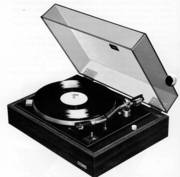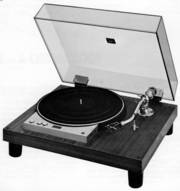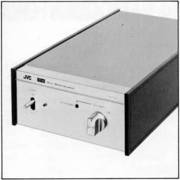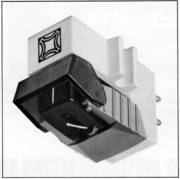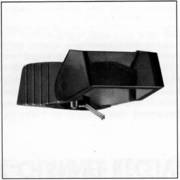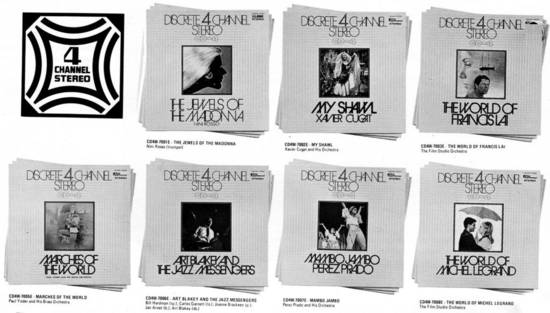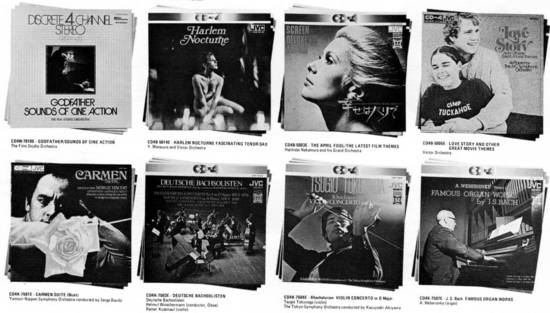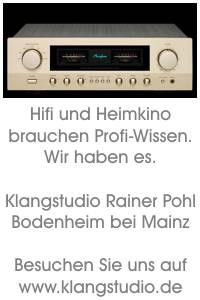CD-4 - A little CHRONOLOGY (from JVC Marketing) März 1973
JVC's research into recording systems using a supersonic modulated carrier started in 1963. Since then there has been intensive research which has resulted in the CD-4 discrete 4-channel record system. Major milestones in its recent development are:
- 1970 Sept. - JVC announced the CD-4 system in Japan and demonstrated it.
- 1970 Oct. - At the 39th AES Convention in New York JVC gave a report "A Discrete 4-Channel Disc and its Reproducing System" and demonstrated the CD-4 system.
- 1971 March - At the 1st Central European AES Meeting JVC read a report "The 4-Channel Disc, CD-4" and demonstrated the CD-4 system.
- 1971 April - At the 40th AES Convention in Los Angeles JVC reported on a number of engineering improvements in the CD-4 system.
- 1971 June - The Shibata stylus, specially designed for the CD-4 system, was announced.
- 1971 June - CD-4 records and playback equipment were released on the Japanese market.
- 1971 July - JVC submitted a technical report "A Discrete 4-Channel Disc and its Reproducing System (CD-4)" to the Journal of the AES.
- 1971 Oct. - At the 41st AES Convention in New York JVC gave a report on "Further Improvements of the Discrete 4-Channel Disc System"
- 1971 Nov. - An announcement was made in New York by JVC, Panasonic and RCA that RCA Records would adopt the CD-4 system.
- 1971 Dec. - The Engineering Committee of the Japan Phonograph Record Association issued standards for the manufacture of CD-4 records.
- 1972 Feb. - A demodulator was developed with a better performance and improved compatibility because of its use of a PLL (Phase Locked Loop) IC.
- 1972 March At the 2nd Central European AES Meeting JVC reported on "Further Improvements in the Discrete 4-Channel System (CD-4)".
- 1972 March The 4DD-10 Demodulator was put on sale in export markets.
- 1972 May RCA Records released CD-4 records in the U.S.A.
- 1972 May At the 42nd AES Convention in Los Angeles JVC reported "On the Reproduction of Discrete 4-Channel Disc, CD-4"
- 1972 June The 4DD-5 fully compatible Demodulator was put on sale in the Japanese and export markets.
- 1972 June JVC submitted a report on "Further Improvements in CD-4" to the Journal of the AES.
- 1972 July The Engineering Committee of the Electronic Industries Association of Japan issued a set of standards for CD-4 hardware.
- 1972 July The number of CD-4 albums released in Japan exceeded 100.
- 1972 July CD-4 record cutting started at RCA's New York studio.
- 1972 Aug. A CD-4 patent was issued in the U.S.A.
- 1972 Sept. At the 43rd AES Convention in New York, JVC gave a paper on "The Technical Requirements of Phono Cartridges for Proper Playback of CD-4 Discrete 4-Channel Records".
- 1972 Nov. A 4-channel receiver 4VR-1006 with a built-in CD-4 demodulator was put on sale.
- 1972 Nov. Teichiku Records and Nippon Phonogram Records released CD-4 records.
- 1972 Dec. The number of CD-4 albums released in Japan exceeded 150.
- 1973 Feb. The WEA Group of companies signed a licensing agreement to produce CD-4 records.
As of March 1973, the hardware companies other than JVC which are committed to the CD-4 system are:
- Panasonic,
- Pioneer,
- Hitachi,
- Mitsubishi,
- Sanyo,
- Onkyo,
- Sharp,
- Trio Kenwood,
- Akai and
- Sansui.
.
MARKETING IN JAPAN (1973)
CD-4 was first sold in Japan in the middle of 1971 and has had unrivalled success since then. Over 60% of the 4-channel records sold are CD-4. This is because CD-4 is the only system which satisfies all the conditions necessary to be really marketable. JVC's prediction which was made early in the development of the CD-4 system, that CD-4 would be the industrywide standard in the years to come, is coming true. Several record companies have already released CD-4 records and several more have stated their intention to do so in the months to come.
More important, other hardware manufacturers, who were or, in some cases, still are involved with matrix pseudo 4-channel systems are incorporating CD-4 demodulators into their latest, top quality amplifiers and receivers. Almost every high quality amplifier being sold in Japan has a built-in CD-4 demodulator. As well as increasing the number of CD-4 users this indicates fcat CD-4 has really been accepted.
Marketing WORLD-WIDE (1973)
Stereo and Hifi have maximum market penetration in the United States. At the moment CD-4 4-channel has had its maximum impact in Japan, but this situation is likely to change. From the start, CD-4 has been accepted by RCA as the only wholly satisfactory 4-channel record system. Their "QUADRA-DISC records are in the CD-4 format. These records are being released every month in increasing numbers and it is RCA's intention to change their entire production to "QUADRA-DISC" records in the near future. The WEA group, the biggest popular record producer in the U.S., has also signed a licensing agreement with JVC to manufacture CD-4 records. JVC has established a wholly owned subsidiary in Los Angeles, JVC Records Inc., to cut CD-4 masters for U.S. record manufacturers. These developments, together with the sales and publicity campaign planned by JVC, should make the U.S. audio buying public fully aware of the CD-4 system during 1973.
In Europe the situation is slightly different because 4-channel records and CD-4 are relatively unknown. At the end of 1972, JVC entertained a party of American and European audio writers. Their comments, combined with the publicity campaign in 1973, should change this situation. JVC's CD-4 equipment will be demonstrated throughout Western Europe in 1973 and JVC's CD-4 records will be available. Very soon, RCA "QUADRADISC" records will be released in Europe, first imported from the U.S.A. and then later cut in Europe.
CD-4 PLAYBACK EQUIPMENT
If a buyer was setting up a CD-4 system as his first venture into the world of audio, he would be able to buy a complete range of components, which have been specially designed to play CD-4 records and get the best out of them. And if an enthusiast with an unlimited budget wanted to set up a CD-4 system, he could do the same. But this is seldom the case. Usually people upgrade their audio systems by adding components to an existing system.
WHAT DO I NEED TO PLAY CD-4 RECORDS?
Your record player will probably be completely satisfactory. The main consideration is, that the signal cords, which connect it to the demodulator, should have a sufficiently low capacitance. JVC makes low capacitance signal cords (LSC-1) and these are available from your JVC dealer. Your cartridge and stylus assembly, unless it is very modern, will almost certainly have to be replaced by one with the wide range frequency response necessary to play CD-4 records to their best advantage.
If a cartridge/stylus with a less wide frequency response is used, although the difference (frequency modulated) signal will be detected, it will not be strong enough to produce the optimum channel separation between the front and rear.
The next component in the system is the only truly essential new component. JVC's newly developed demodulator is necessary for playing CD-4 records. You can buy it as a separate component or built-in with a record player, receiver, amplifier or console.
Fully discrete 4-channel amplification is, of course, necessary. Some audiophiles will already have an integrated 4-channel amplifier. Others may chose to buy an add-on amplifier such as JVC's model VN-5101; these can be used to give an existing 2-channel amplifier a 4-channel ability. And still others will chose to buy a 4-channel amplifier or receiver. Four identical speakers are the ideal, but many people will prefer initially to buy only one pair of new speakers. To get the best possible sound from a CD-4 system, it is better, to buy omni-directional speakers for the rear pair of speakers.
SRP-473E - precision-built 2-speed turntable with "Sure-Tracking" tonearm
The SRP-473E is specially designed to be ready for the age of discrete 4-channel sound. It comes fitted with a 4-channel cartridge and has the low capacitance signal cords necessary in the CD-4 system. To upgrade this record player to full CD-4 specification, all that is needed is a Shibata stylus JVC's 4DT-10X from your dealer.
The 4-pole synchronous motor ensures precise speeds and reduced vibration and noise. It uses a belt to drive the high inertia aluminum diecast platter; this further improves the system, getting the wow and flutter down to less than 0.1% WRMS. The universal tonearm is specially designed to provide stable tracking at low stylus pressures. 7-1/4"(H)x18-3/16"(W)x14-9/16"(D), 22 lbs.
VL-8 — a very special record player
A top performance precision 2-speed turntable and a high class tonearm put the VL-8 in a class by itself. The high inertia turntable is driven by a brushless DC servo motor which reduces wow and flutter to less then 0.05% WRMS. A built-in stroboscope provides an additional check that the speed is exactly correct and fine adjustment controls allow precise setting. The universal tonearm is statically balanced for stable tracking at light stylus pressures and is provided with an anti-skating bias adjustment device. The record player is ideal for every hi-fi system and, fitted with a CD-4 compatible cartridge, gives the best quality possible of discrete 4-channel sound.
7-1/2"(H)x19-3/8"(W)x16-1/4"(D), 22 lbs.
4DD-5 Demodulator
This is the unique component, that makes CD-4 discrete 4-channel sound possible. Although it's possible to buy demodulators built-in to many stereo components, many audiophiles will prefer to buy a separate component demodulator,
The 4DD-5 makes your stereo system completely 4-channel/2-channel compatible: you can switch it to 2CH and the signals from the record player bypass the demodulator completely. Or you can switch it to 4CH AUTO: in this mode a logic circuit examines the signal from the record player and only demodulates it if it is a CD-4 signal.
The 4DD-5 was designed by highly professional engineers and uses top quality components. 6 ICs, 6 FETs, 27 transistors and 23 semiconductor diodes are used in its construction. It will give years of service and satisfaction. 3-3/8"(H)x6-7/8"(W)x12-3/4"(D), 5 lbs.
Anmerkung:
Im Englischen bedeutet "construction" = Baustelle, im Deutschen eine Konstruktion, und vermutlich im Japanischen auch.
4MD-20X Unique 4-Channel/2-Channel Cartridge
This cartridge was specially developed for use with CD-4 records, but its improved characteristics give it advantages over other cartridges when used in a conventional 2-channel stereo system.
It uses a V-shaped moving magnet attached to a SHIBATA stylus. The magnet moves between highly precise coils. The frequency response is from 20 to 60,000Hz; this is a much wider range than ever before, but is necessary in the CD-4 system.
Its output is 2.0mV at 1kHz and 50mm/s. The channel separation is better than 30dB at 1kHz and 20dB at 30kHz. It tracks at a stylus pressure of between 1.5 and 2.0 grams and its compliance is 35 x 1CT6 cm/dyne.
4DT-20X The SHIBATA Stylus
This is the stylus used in JVC's CD-4 cartridges and was specially developed for the CD-4 system. Its new shape enables it to trace the record groove much more exactly than any conventional stylus with the advantage, since the area of contact with the groove is four times greater, less wear on the record or stylus and longer life for both.
The larger area of contact with the record groove means that the record is "stiffer" than was before possible. This increases the mechanical resonance frequency, which in turn increases the electrical resonance frequency and extends the frequency range by 40 to 50%.
The greater accuracy of groove tracing improves the S/N ratio and produces less waveform and phase distortion.
Although the SHIBATA stylus was designed specially for use in the CD-4 system its improved characteristics are apparent when playing 2-channel stereo records.
4-CHANNEL INTEGRATED AMPLIFIERS
JVC manufactures a comprehensive range of discrete 4-channel integrated amplifiers which, connected to a demodulator, give CD-4 4-channel sound.
4VN-990
The 4VN-990's rear panel connection jacks provide for two 4-channel speaker systems, a 4-channel tape recorder — both record and playback, a CD-4 demodulator and a further 4-channel source. Then there are jacks for a 2-channel tape recorder, two 2-channel stereo phonographs and two further 2-channel sources. A 5-element S.E.A. unit gives better than ever control over the tone of your 4-channel soundfield and lets you compensate for the acoustics of your room in a way no other system can do. 5-3/8"(H)x16-5/8"(W)x15-3/8"(D), 35.2 lbs.
4VN-880
This powerful 4-channel amplifier gives 240 watt, room filling, output. And everything is separate from input to output. The 4 pre-amps with their level controls and level meters drive 4 separate power amplifiers. JVC's unique SFCS is a matrix circuit which decodes matrix records and can be used to produce a 4-channel effect from 2-channel sources. Selectable phono input impedance, protection circuits which protect the speakers and electronic components separately and a 18Hz subsonic filter are further features which make the 4VN-880 attractive and marketable. 5-3/8"(H)x16-1/2"(W)x14-1/4"(D), 26.4 lbs.
4VN-770
A room filling 100 watts of 4-channel sound. Or, with the BTL (Balanced Transformer-Less) connection — super-powerful 100 watt 2-channel sound. The 4VN-770 has a full range of rear panel connections, both 4-channel and 2-channel. The separable pre-amps and power amps can be used in a multi-channel system. All this and JVC's SFCS matrix circuit which decodes matrix records and produces a 4-channel effect from regular 2-channel sources. 5-1/2"(H)x16-1/2"(W)x12"(D), 21.4 lbs.
4VN-550
This is a flexible 4-channel integrated amplifier with power enough for most applications, and flexibility that will enhance any stereo system. BTL doubles the power when it's used for 2-channel operation. And JVC's SFCS gives it matrix capability. Features like the loudness circuit which improves the tone at low volumes, the high cut filter which eliminates unpleasant tape hiss, the 4-channel headphone jacks and the socket for the connection of JVC's 5911 Balance Remote Control are all points which make the 4VN-550 a winner. 5-3/8"(H)x15-1/2"(W)x12"(D), 18.5 lbs.
CD-4 SOFTWARE
By March 1973 JVC had released more than 160 CD-4 albums in Japan; some of these are illustrated below. In Japan some other record manufacturing companies have already started to release CD-4 albums and more intend to do so in the near future.
The situation outside Japan is, that RCA has started to make monthly releases of CD-4 format "Quadradisc" records in the U.S.A. and will extend this to Europe and another large international group, the WEA group, has signed a licensing agreement for the production of CD-4 format records.
Hier die damaligen CD-4 Glanzleistungen
| CD4W 7001E | THE JEWELS OF THE MADONNA - Nini Rosso (trumpet) |
| CD4W 70G2E | MY SHAWL - Xavier Cugat and His Orchestra |
| CD4W 7003E | THE WORLD OF FRANCIS LAI - The Film Studio Orchestra |
| CD4W 7005E | MARCHES OF THE WORLD - Paul Yoder and His Brass Orchestra |
| CD4W 7006E | ART BLAKEY AND THE JAZZ MESSENGERS - Bill Hardman (tp); Carlos Garnett (ts.); Joanne Brackeen (p.); Jan Arnet(b.);ArtBlakey(ds.) |
| CD4W 7007E | MAMBO JAMBO - Perez Prado and His Orchestra |
| CD4W 7008E | THE WORLD OF MICHEL LEGRAND - The Film Studio Orchestra |
| CD4W 7010E | GODFATHER/SOUNDS OF CINE ACTION - The Film Studio Orchestra |
| CD4B 5014E | HARLEM NOCTURNE FASCINATING TENOR SAX - Y. Matsuura and Victor Orchestra |
| C04B 5003E | THE APRIL FOOL/THE LATEST FILM THEMES - Hachidai Nakamura and his Grand Orchestra |
| CD4B 5005E | LOVE STORY AND OTHER GREAT MOVIE THEMES - Victor Orchestra |
| CD4K 7501E | CARMEN SUITE |
| CD4K 7503E | DEUTSCHE BACHSOLISTEN - Deutsche Bachsolisten - Helmut Winschermann (conductor, Oboe) Rainer Kussmaul (violin) |
| CD4K 7504E | Khachaturian VIOLIN CONCERTO in 0 Major - Tsugio Tokunaga (violin) - The Tokyo Symphony Orchestra conducted by Kazuyoshi Akiyama |
| CD4K 7507E | J. S. Bach FAMOUS ORGAN WORKS - A.Webersmke (organ) |
THE CD-4 FUTURE
CD-4 records and playback equipment are now being marketed world-wide. Other manufacturers as well as JVC are involved in both these facets of production. And JVC is continuing in its development. These are three very important facts. The evidence is that JVC has developed a 4-channel recording system which will be used as the world standard for many years to come. The CD-4 system is sufficiently flexible to allow further research to improve many aspects of record production and reproduction techniques without making the playback equipment and records now being marketed obsolete. This is a most powerful recommendation for audio enthusiasts to invest in the CD-4 system.
Das war die Vision . . . . . von 1973 und 1974 . . . . .
Doch es wurde ein gigantischer Flop.
.

